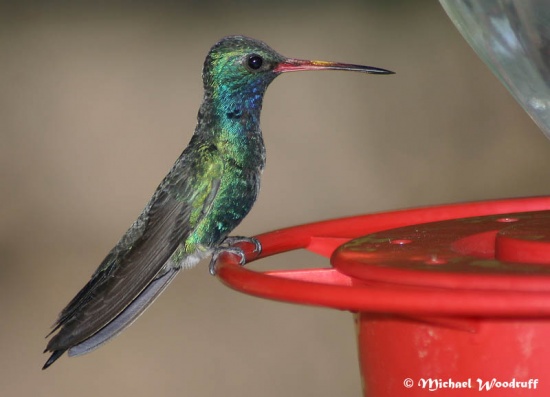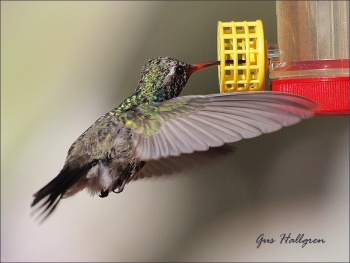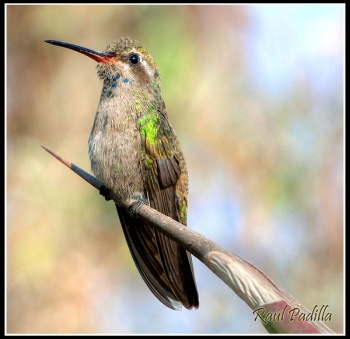Nomdeploom (talk | contribs) |
(Attempt to disguise copied text. Pictures of female & Immature added. Taxonomy expanded. References) |
||
| Line 1: | Line 1: | ||
| − | [[ | + | ;[[:Category:Cynanthus|Cynanthus]] latirostris |
| − | |||
'''Includes Doubleday's Hummingbird''' | '''Includes Doubleday's Hummingbird''' | ||
| − | + | [[Image:Broad-billed_Hummingbird.jpg|thumb|550px|right|Male<br />Photo by {{user|Michael+W|Michael W}} <br />Paton's Feeders, Patagonia, [[Arizona]], [[USA]], June 2005]] | |
==Identification== | ==Identification== | ||
| − | 9-10cm | + | 9-10cm<br /> |
| − | + | '''Male''' | |
| + | *Metallic green upperparts and breast | ||
| + | *White undertail coverts | ||
| + | *Deep blue throat | ||
| + | *Dark, slightly forked tail | ||
| + | *Black-tipped slender red bill<br /> | ||
| + | [[Image:BB F.jpg|thumb|350px|right|Female<br />Photo by {{user|UncleGus_24|UncleGus_24}}<br />Green Valley, [[Arizona]], February 2010]] | ||
| + | '''Female''': less colourful, white eye stripe. | ||
==Distribution== | ==Distribution== | ||
| − | Southwestern [[United States]] to southern [[Mexico]] and Tres Marias Islands | + | Southwestern [[United States]] to southern [[Mexico]] and Tres Marias Islands. |
| + | Accidental vagrant to [[Kansas]]. | ||
==Taxonomy== | ==Taxonomy== | ||
| + | ====Subspecies<sup>[[#References|[1]]]</sup>==== | ||
| + | There are 5 subspecies: | ||
| + | *''C. l. magicus'': | ||
| + | :*Arid south-western [[US]] to north-western [[Mexico]] (Nayarit) | ||
| + | *''C. l. latirostris'': | ||
| + | :*Eastern [[Mexico]] (San Luis Potosí and Tamaulipas to northern Veracruz) | ||
| + | [[Image:Broad-billed HummingbirdIm.jpg|thumb|350px|right|Immature<br />Photo by {{user|Raul+Padilla|Raul Padilla}}<br />Pachuca, Hidalgo, [[Mexico]], May 2010]] | ||
| + | *''C. l. propinquus'': | ||
| + | :*Central [[Mexico]] (Guanajuato to Michoacán) | ||
| + | *''C. l. doubledayi'': (Doubleday's): | ||
| + | :*Southern [[Mexico]] (Guerrero, Oaxaca and Chiapas) | ||
| + | *''C. l. lawrencei'': | ||
| + | :*Tres Marías Islands (off western [[Mexico]]) | ||
| + | |||
Some authorities<sup>[[#References|3]],[[#References|4]]</sup> split Doubleday's Hummingbird ''Cynanthus doubledayi'' from this taxon and others<sup>[[#References|1]],[[#References|2]]</sup> retain it as a subspecies of ''Cynanthus latirostris''. | Some authorities<sup>[[#References|3]],[[#References|4]]</sup> split Doubleday's Hummingbird ''Cynanthus doubledayi'' from this taxon and others<sup>[[#References|1]],[[#References|2]]</sup> retain it as a subspecies of ''Cynanthus latirostris''. | ||
==Habitat== | ==Habitat== | ||
| − | + | Lower riparian woods, forested mountains (observed to 5500 feet), high desert, oak and Alligator pine, orange groves. Visits backyard feeders. | |
==Behaviour== | ==Behaviour== | ||
| − | The female builds the nest in a tree or shrub | + | ====Breeding==== |
| − | + | The female builds the nest in a tree or shrub. The clutch consists of 2 white eggs. | |
| + | ====Diet==== | ||
The diet includes nectar and insects. | The diet includes nectar and insects. | ||
==References== | ==References== | ||
| Line 22: | Line 44: | ||
# Gill F & Wright M. 2008. ''Birds of the World: Recommended English Names''. Princeton University Press, Princeton NJ, USA. 2006. ISBN 9780691128276 Update (2008) downloaded from [http://worldbirdnames.org/names.html http://worldbirdnames.org/names.html]. | # Gill F & Wright M. 2008. ''Birds of the World: Recommended English Names''. Princeton University Press, Princeton NJ, USA. 2006. ISBN 9780691128276 Update (2008) downloaded from [http://worldbirdnames.org/names.html http://worldbirdnames.org/names.html]. | ||
# Sibley CG & Monroe BL. 1996. ''Birds of the World'', on diskette, Windows version 2.0. Charles G. Sibley, Santa Rosa, CA, USA. | # Sibley CG & Monroe BL. 1996. ''Birds of the World'', on diskette, Windows version 2.0. Charles G. Sibley, Santa Rosa, CA, USA. | ||
| + | #BF Member observations | ||
| + | #Wikipedia | ||
| + | {{ref}} | ||
==External Links== | ==External Links== | ||
{{GSearch|Cynanthus+latirostris}} | {{GSearch|Cynanthus+latirostris}} | ||
[[Category:Birds]] [[Category:Cynanthus]] | [[Category:Birds]] [[Category:Cynanthus]] | ||
Revision as of 19:46, 2 August 2010
- Cynanthus latirostris
Includes Doubleday's Hummingbird
Identification
9-10cm
Male
- Metallic green upperparts and breast
- White undertail coverts
- Deep blue throat
- Dark, slightly forked tail
- Black-tipped slender red bill
Female: less colourful, white eye stripe.
Distribution
Southwestern United States to southern Mexico and Tres Marias Islands.
Accidental vagrant to Kansas.
Taxonomy
Subspecies[1]
There are 5 subspecies:
- C. l. magicus:
- C. l. latirostris:
- Eastern Mexico (San Luis Potosí and Tamaulipas to northern Veracruz)
- C. l. propinquus:
- Central Mexico (Guanajuato to Michoacán)
- C. l. doubledayi: (Doubleday's):
- Southern Mexico (Guerrero, Oaxaca and Chiapas)
- C. l. lawrencei:
- Tres Marías Islands (off western Mexico)
Some authorities3,4 split Doubleday's Hummingbird Cynanthus doubledayi from this taxon and others1,2 retain it as a subspecies of Cynanthus latirostris.
Habitat
Lower riparian woods, forested mountains (observed to 5500 feet), high desert, oak and Alligator pine, orange groves. Visits backyard feeders.
Behaviour
Breeding
The female builds the nest in a tree or shrub. The clutch consists of 2 white eggs.
Diet
The diet includes nectar and insects.
References
- Clements JF. 2007. The Clements Checklist of Birds of the World. 6th ed., with updates to October 2008. Cornell University Press. ISBN 9780801445019
- Dickinson EC (ed.) 2003. The Howard & Moore Complete Checklist of the Birds of the World. 3rd ed. Princeton Univ. Press, Princeton, NJ, USA. ISBN 9780691117010
- Gill F & Wright M. 2008. Birds of the World: Recommended English Names. Princeton University Press, Princeton NJ, USA. 2006. ISBN 9780691128276 Update (2008) downloaded from http://worldbirdnames.org/names.html.
- Sibley CG & Monroe BL. 1996. Birds of the World, on diskette, Windows version 2.0. Charles G. Sibley, Santa Rosa, CA, USA.
- BF Member observations
- Wikipedia
Recommended Citation
- BirdForum Opus contributors. (2024) Broad-billed Hummingbird. In: BirdForum, the forum for wild birds and birding. Retrieved 27 April 2024 from https://www.birdforum.net/opus/Broad-billed_Hummingbird






